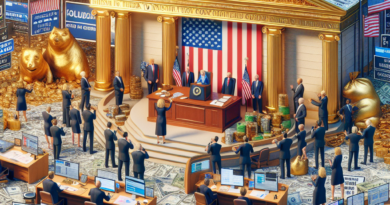S&P 500 Outlook 2025: Factors Likely to Hinder Index Growth
“`html
Market Predictions for 2025: Uncertainties Ahead
As we look ahead to 2025, the economic landscape appears fraught with uncertainties, even though the IMF forecasts a global growth rate of 3.2%.
Beneath this seemingly optimistic figure lie critical factors that might hinder the expected growth of the S&P 500 and other global financial markets.
Concerns such as inflation, divergent monetary policies, and global imbalances are at the forefront of investors’ minds.
These issues may push them towards safer asset classes, potentially leading to detrimental effects on equity markets.
Key Factors Impeding Economic Growth in 2025
1) Inflation
Inflation stands as a primary concern heading into 2025.
Paul Tudor Jones, famed for his prediction of the 1987 market crash, anticipates a resurgence of inflation driven by the fiscal policies of the upcoming U.S.
president.
Irrespective of election outcomes, both candidates are likely to promote expansive fiscal strategies that boost consumer spending.
With demand outpacing supply, consumer prices are bound to rise, necessitating further interest rate hikes.
The consequent uncertainty may prompt investors to seek refuge in secure assets like gold.
2) U.S.
Debt
The colossal public debt in the U.S.
could also hinder market growth in 2025.
According to the Congressional Budget Office (CBO), the U.S.
deficit is projected to reach $2.8 trillion by 2034, leading to a debt-to-GDP ratio soaring to 122%.
To navigate this predicament, the U.S.
may have to rely on inflation, as noted by Tudor Jones.
This reliance could drive bond yields higher and elevate financing costs.
The uncertainty surrounding U.S.
debt management is likely to exert pressure on global markets, heightening volatility and eroding investor confidence in fixed-income markets.
3) Technology Sector in the U.S.
A significant threat to growth in 2025 might emerge from the U.S.
technology sector, which is intricately connected to global interest rate dynamics, especially those in Japan.
Currently, the real interest rate differential between Japan and the U.S.
stands at -5.4%.
BCA Research suggests this disparity has inflated valuations in tech stocks, particularly in the artificial intelligence sector with companies like Nvidia experiencing booms.
This phenomenon is partially fueled by “carry trade” activities, where investors borrow yen at low rates to invest in riskier assets, including U.S.
tech stocks.
A warning sign appeared last summer when the Bank of Japan hinted at potentially ending its zero interest rate policy (ZIRP), causing a temporary drop in tech stock valuations, highlighting their vulnerability to possible rate increases in Japan.
Any increase in Japanese rates could lead investors to pare back their exposure to tech stocks, reinforcing the yen and signaling a broader caution in the technology market.
For related information, read more about the signs that Big Tech may be poised for a decline.
Disclaimer
The information and opinions in this article should not be considered the sole basis for investment decisions.
Readers retain full freedom in their investment choices and assume complete responsibility for them, as they alone understand their risk tolerance and time horizon.
The content provided is purely for informational purposes and does not constitute an offer or solicitation for public savings.
“`




